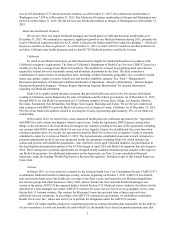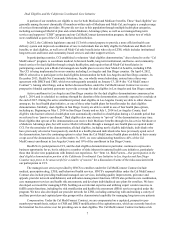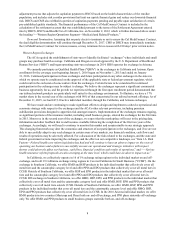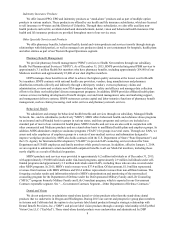Health Net 2015 Annual Report Download - page 17
Download and view the complete annual report
Please find page 17 of the 2015 Health Net annual report below. You can navigate through the pages in the report by either clicking on the pages listed below, or by using the keyword search tool below to find specific information within the annual report.15
regulations that may directly or indirectly affect premium setting including, for example, premium loads for ACA-
related taxes and fees assessed to health plans. Also, for policy years beginning January 1, 2014 and beyond, the ACA
does not allow rating based on claims experience for small group and individual business. See “Item 1A. Risk Factors
—We face competitive and regulatory pressure to contain premium prices. If the premiums we charge are insufficient to
cover our health care costs, it could have a material adverse effect on our business, financial condition or results of
operations” for additional information on regulations and legislation impacting our premium setting. Mandated benefits
(requiring the coverage of certain benefits as a matter of law, whether desired by the group or not) also impact
premiums. For example, in California and elsewhere, the ACA has impacted the scope of “essential health benefits” that
health plans are required to offer, and mental health parity laws have generally broadened mental health benefits under
health insurance policies offered by us and other carriers.
The ACA eliminated medical underwriting for medical insurance coverage decisions, including with respect to
preexisting conditions (known as “guaranteed issue”). For additional detail on these and other requirements of the ACA,
as well as certain associated risks, see “—Government Regulation—Health Care Reform Legislation and
Implementation” and “Item 1A. Risk Factors—Federal health care reform legislation has had and will continue to have
an adverse impact on the costs of operating our business and a failure to successfully execute our operational and
strategic initiatives with respect thereto could adversely affect our business, cash flows, financial condition and results
of operations.”
Information Technology
Our business depends significantly on effective and efficient information systems. The information gathered and
processed by our information management systems assists us in, among other things, pricing our services, monitoring
utilization and other cost factors, processing provider claims, billing our customers on a timely basis, identifying
accounts for collection and detecting fraud, security threats and other risks. Our customers and providers also depend
upon our information systems for membership verification, claims status and other information. We have many different
information systems that support our various lines of business and we develop new systems as needed to keep pace with
continuing changes in technology and to support our operational needs, including potential business expansions. These
systems require the ongoing commitment of significant resources for continual maintenance, upgrading and
enhancement to meet our operational needs, evolving industry and regulatory standards, compliance with legal
requirements (such as the ACA and ICD-10 (as defined below) and changing customer preferences).
We have partnered with third parties to support our information technology systems and to help design, build,
test, implement and maintain our information management systems. Our merger, acquisition and divestiture activity,
including the pending Merger with Centene, has required us to expend resources and incur expenses in preparation for
transitions to and from, as well as the integration of, various information management systems within our overall
enterprise architecture.
We successfully completed implementation of the changes related to CMS mandated ICD-10, which significantly
expanded the number of codes utilized in claims processing. This implementation was completed ahead of the
mandated deadline of October 1, 2015. In an effort to consolidate our claims and membership processing to a single
system, we took another step towards that goal in 2015 by installing our Medi-Cal membership on our designated
platform. This completed our migration to a single claims payment platform. We continue to expend resources our
membership consolidation effort as we retire legacy systems.
For additional information on our information technology and associated risks, see Item 1A. Risk Factors—If we
fail to effectively maintain our information management systems, it could adversely affect our business,” “Item 1A. Risk
Factors—We are subject to risks associated with outsourcing services and functions to third parties,” and “Item 1A.
Risk Factors—If we or our business associates that handle certain information on our behalf fail to comply with
requirements relating to patient privacy and information security, among other things, our reputation and business
operations could be materially adversely affected.”
Medical Management
We believe that managing health care costs is an essential function for a managed care company. Among the
medical management techniques we utilize to contain the growth of health care costs are pre-authorization or
certification for certain outpatient services and inpatient hospitalizations and a concurrent review of active inpatient
hospital stays and discharge planning. We believe that this authorization process, along with the inherent features of a
capitation payment model, helps to reduce inappropriate use of medical resources and achieve efficiencies in referring
cases to the most appropriate providers. We provide multiple models of care management and case management to our
members, and also contract with third parties to manage certain conditions such as neonatal intensive care unit
























